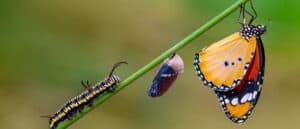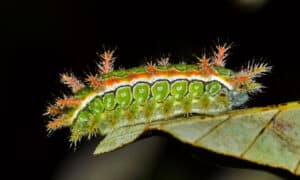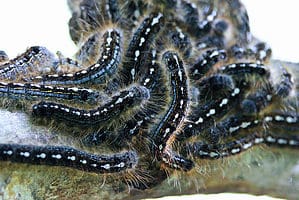Has something been munching on your favorite plants? Then you may have a few caterpillar guests getting ready for their next form, the chrysalis. Caterpillars are the larval stage of butterflies and moths. During this stage, caterpillars eat a lot. They need a lot of energy during their metamorphosis. Caterpillars don’t stay caterpillars for long though. In about 2 to 5 weeks, they move on to their next form.
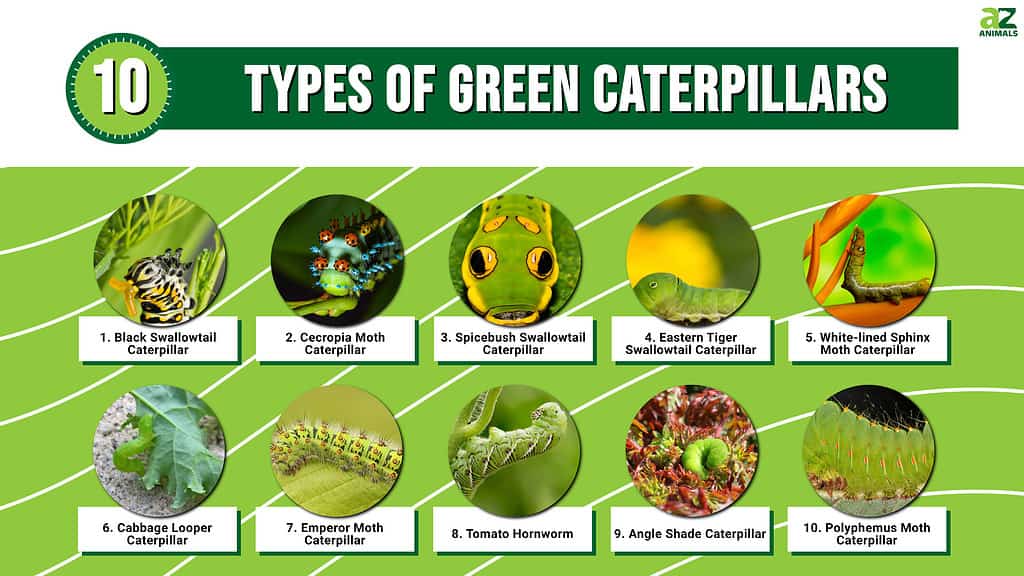
There are hundreds of caterpillars, all with unique colors, patterns, and textures. Still, many are green or have green markings. Listed below are 10 types of green caterpillars and how to identify them.
1. Black Swallowtail Caterpillar
Black swallowtail butterflies are beautiful, but before they transform into butterflies, they are bright and long caterpillars. These vibrant caterpillars are green, orange, yellow, and black. They also have an orange osmeterium, a defensive organ. When threatened or scared, black swallowtail caterpillars are visible and release a foul smell. These caterpillars have many defense mechanisms. For example, they taste bitter because they absorb toxins from plants. Birds avoid eating black swallowtail caterpillars. Another name for this caterpillar is the parsley worm. They mainly feed on parsley and lay their eggs on the plant.
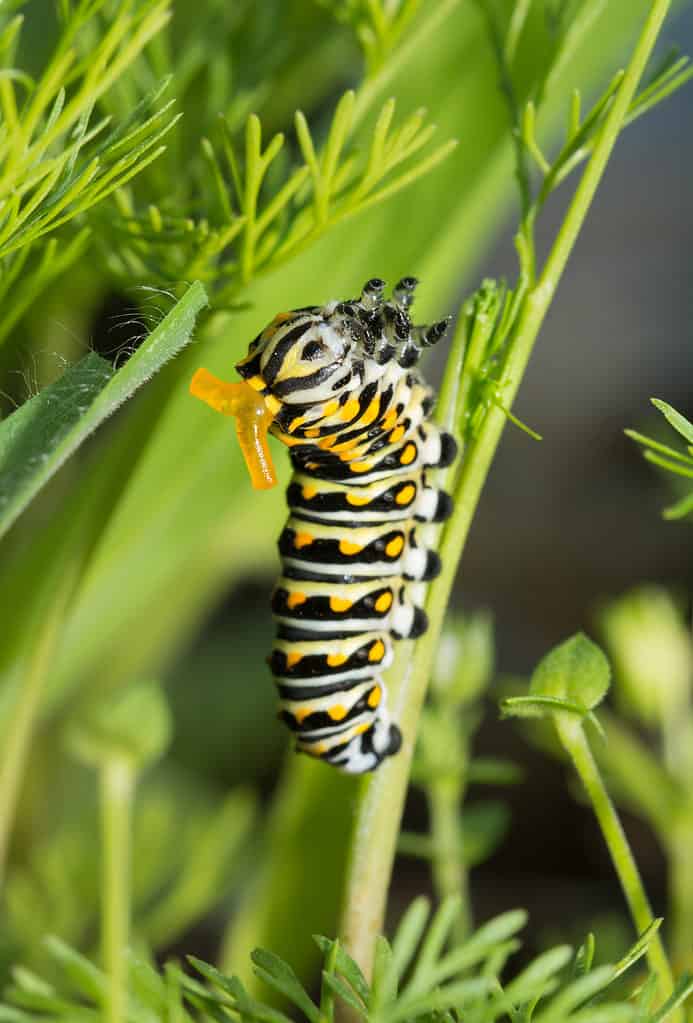
Black swallowtail caterpillars are green, orange, and black.
©Sari ONeal/Shutterstock.com
2. Cecropia Moth Caterpillar
Another type of green caterpillar is the cecropia moth caterpillar. These brightly colored caterpillars are commonly found on trees, like maple, birch, and apple. Cecropia moth caterpillars aren’t green when they hatch. Instead, they hatch as black caterpillars and remain this color for about a week. When they reach the next larval state in week 2 after eating, they become yellow-green. In the last three stages, they grow larger, thicker, and bluish-green.
These caterpillars are covered in many tubercles (small projections) that can be many colors including orange, blue, and yellow. Cecropia moth caterpillars spin large brown cocoons in autumn after they’ve reached about 4 to 5 inches in length. These large caterpillars eventually develop into North America’s largest native moth. You can find them as far west as Washington.
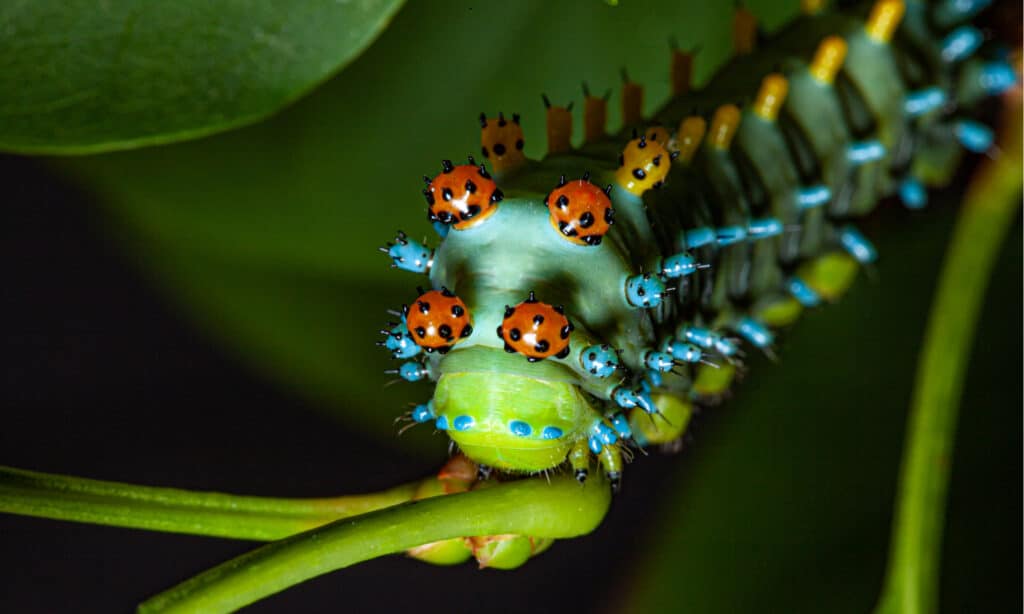
Cecropia moth caterpillars are blueish-green when mature and reach a maximum length of around 5 inches.
©K Hanley CHDPhoto/Shutterstock.com
3. Spicebush Swallowtail Caterpillar
Next on our list of types of green caterpillars is the spicebush swallowtail caterpillar. They are very common and found throughout the eastern US and southern Ontario. However, you can find these butterflies as far as Cuba. Spicebush swallowtail caterpillars are easy to identify because of their unique spots and markings. These caterpillars look like they have large black and yellow eyes with small white eyebrows. During the early stages, though, they are brown and resemble bird droppings. This helps them hide from their predators. As they grow, they resemble a snake and sometimes move their bodies to mimic the movements and scare away birds. Spicebush swallowtail caterpillars also have red osmeterium that they flash when threatened. The y-shaped organ can look like a snake’s tail.
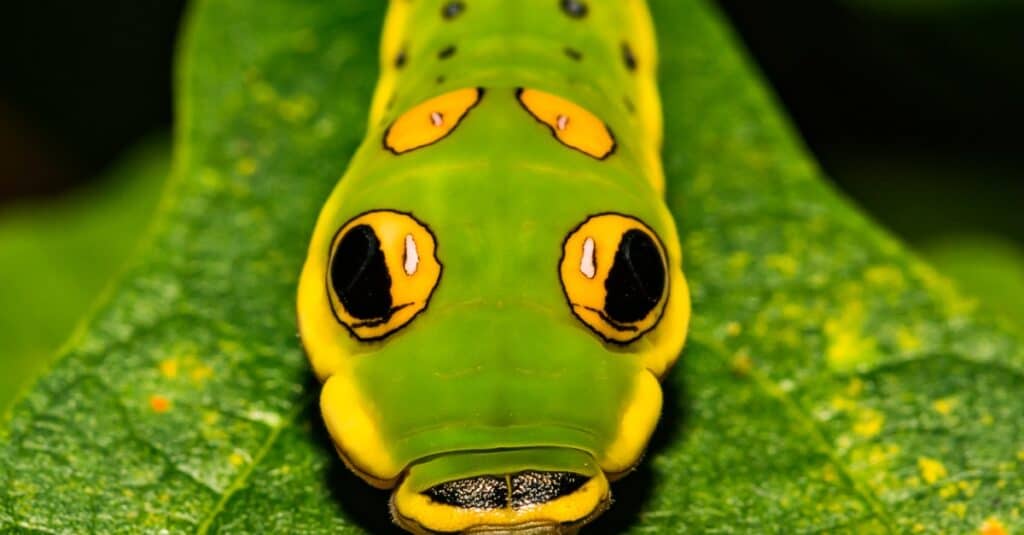
Older spicebush swallowtail caterpillars are bright green, with yellow and black spots on top of their bodies helping them mimic the appearance of snakes.
©iStock.com/JasonOndreicka
4. Eastern Tiger Swallowtail Caterpillar
Another green swallowtail caterpillar is the eastern tiger swallowtail caterpillar, which like the spicebush swallowtail, has unique markings and spots. It’s a very common caterpillar in the eastern United States. So common that the eastern tiger swallowtail butterfly is the state insect of many states, like North Carolina, Alabama, Georgia, and South Carolina.
These caterpillars are brown for the first three instars (developmental stages). After they shed in the fourth instar, they become green. However, they are best known for their swollen thorax, which has two black, yellow, and blue eyespots. The eyespots are small but pop against the bright green. They reach a length of 2.2 inches and after the last instar; they move onto the next stage and live in a chrysalis.

During the fourth instar, the eastern tiger swallowtail caterpillar is bright green and has two black, yellow, and blue eyespots.
©Jay Ondreicka/Shutterstock.com
5. White-lined Sphinx Moth Caterpillar
The white-lined sphinx moth caterpillar is unique. They range in colors in the early instars but have consistent adult coloration. They are first black with orange spots down their back. White-lined sphinx moth caterpillars are also green or orange. Their head’s prothoracic shield and anal plate are one solid color. They also have a tail-like spine protruding from the back of their bodies. White-lined sphinx caterpillars are not harmful to humans. The spine, also known as a horn, is not a stinger. White-lined sphinx moth caterpillars are a stage in the lifecycle of the hummingbird moth. They have large brown wings and furry bodies.

The white-lined sphinx moth caterpillar ranges a lot in color but is usually green and orange.
©Wallenrock/Shutterstock.com
6. Cabbage Looper Caterpillar
Another type of green caterpillar is the cabbage looper caterpillar. They are very common in gardens and can be considered a pest to some since they attack young cabbages. Cabbage looper caterpillars mainly consume plants in the family Brassicaceae like cabbages and broccoli. However, you can find these lime-green caterpillars on over 160 plants. After these caterpillars hatch from their eggs, they are green with a white stripe on the side. Although they are hairy when they hatch, cabbage looper caterpillars lose most of their hair. They only stay in this form for about 2 to 3 weeks and can have 4 to 7 instars within 9 to 14 days. Eventually, these small caterpillars eat three times their weight in a day. Cabbage looper caterpillars also have many predators including ladybeetles and ants.
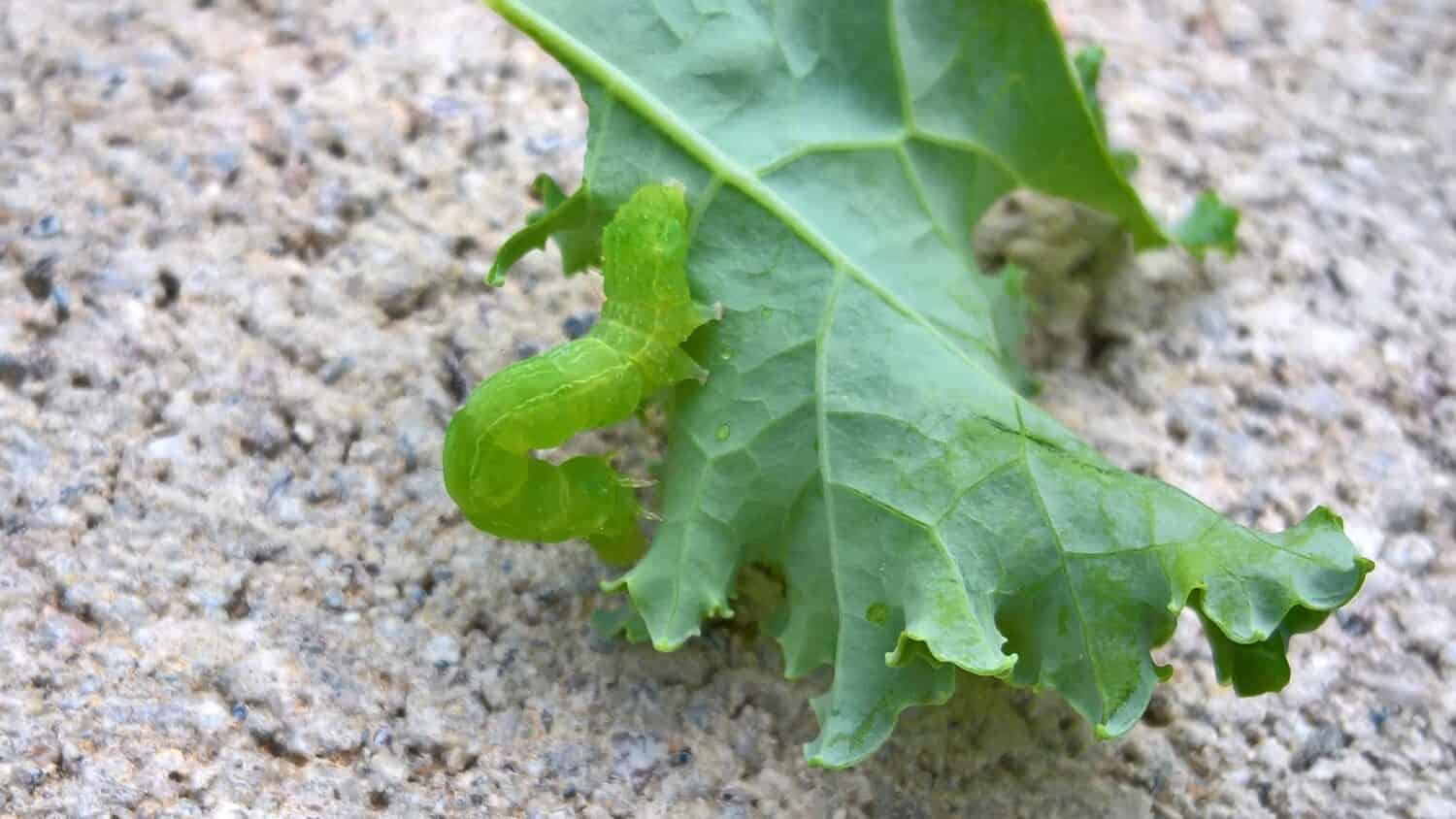
The cabbage looper caterpillar is bright lime-green and mainly consumes plants in the cabbage family.
©amy71465/Shutterstock.com
7. Emperor Moth Caterpillar
Before small emperor moths can spread their wings and fly, they go through many changes and forms. Emperor moth caterpillars are long and furry. They are first black and orange, but later become green with black rings and yellow and red spots. These long and furry caterpillars aren’t picky eaters, but they are commonly found snacking on heather plants. Emperor moth caterpillars are native throughout the Palearctic region.
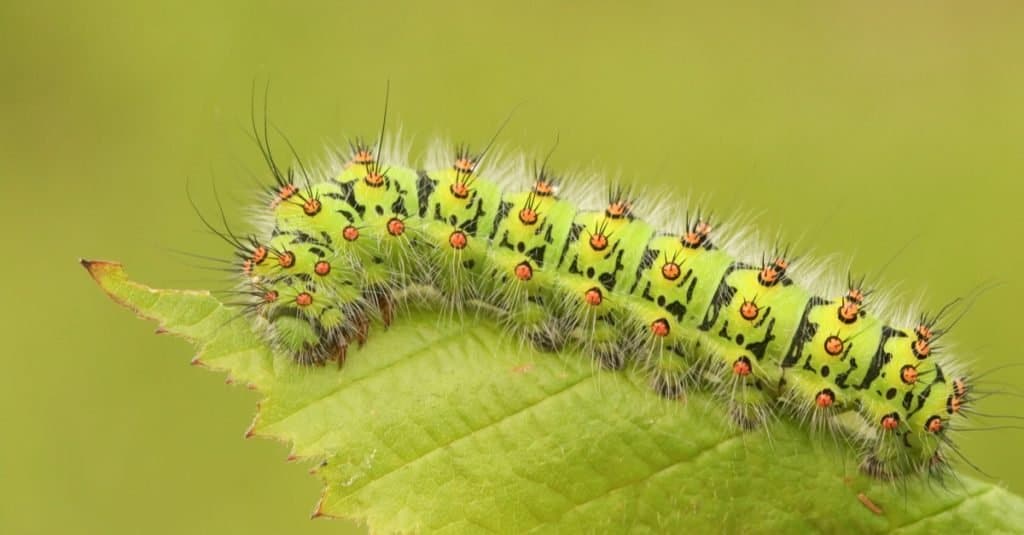
Emperor moth caterpillars are bright green with black rings and yellow and red spots.
©Sandra Standbridge/Shutterstock.com
8. Tomato Hornworm
Tomato hornworms are another type of green caterpillar. They are easy to spot and identify because of their white and black stripes and multiple eyespots. These caterpillars are also known as five-spotted hawkmoth caterpillars. Tomato hornworms are very destructive. They mainly target tomato plants and hide in leaves, folding them up with sticky silk. Although they mainly consume tomato plants, you can find them on various peppers and moonflowers. Tomato hornworms are long reaching up to 3.9 inches long. These caterpillars mainly hatch during late spring to early summer.

Tomato hornworms are green caterpillars that can be found on tomato plants.
©J Gillispie/Shutterstock.com
9. Angle Shade Caterpillar
Angle-shade caterpillars are bright green and thick. They are found throughout the world, including Europe, Asia Minor, Armenia, and Syria. Although they eventually become green, angle shades caterpillars are pinkish brown. They also have very pale dots and a white dorsal line. These vibrant caterpillars aren’t picky eaters and have been recorded eating strawberries, beets, apples, lettuces, nettles, and broccolis. They are very common in gardens and turn into large brown moths with unique angular markings.
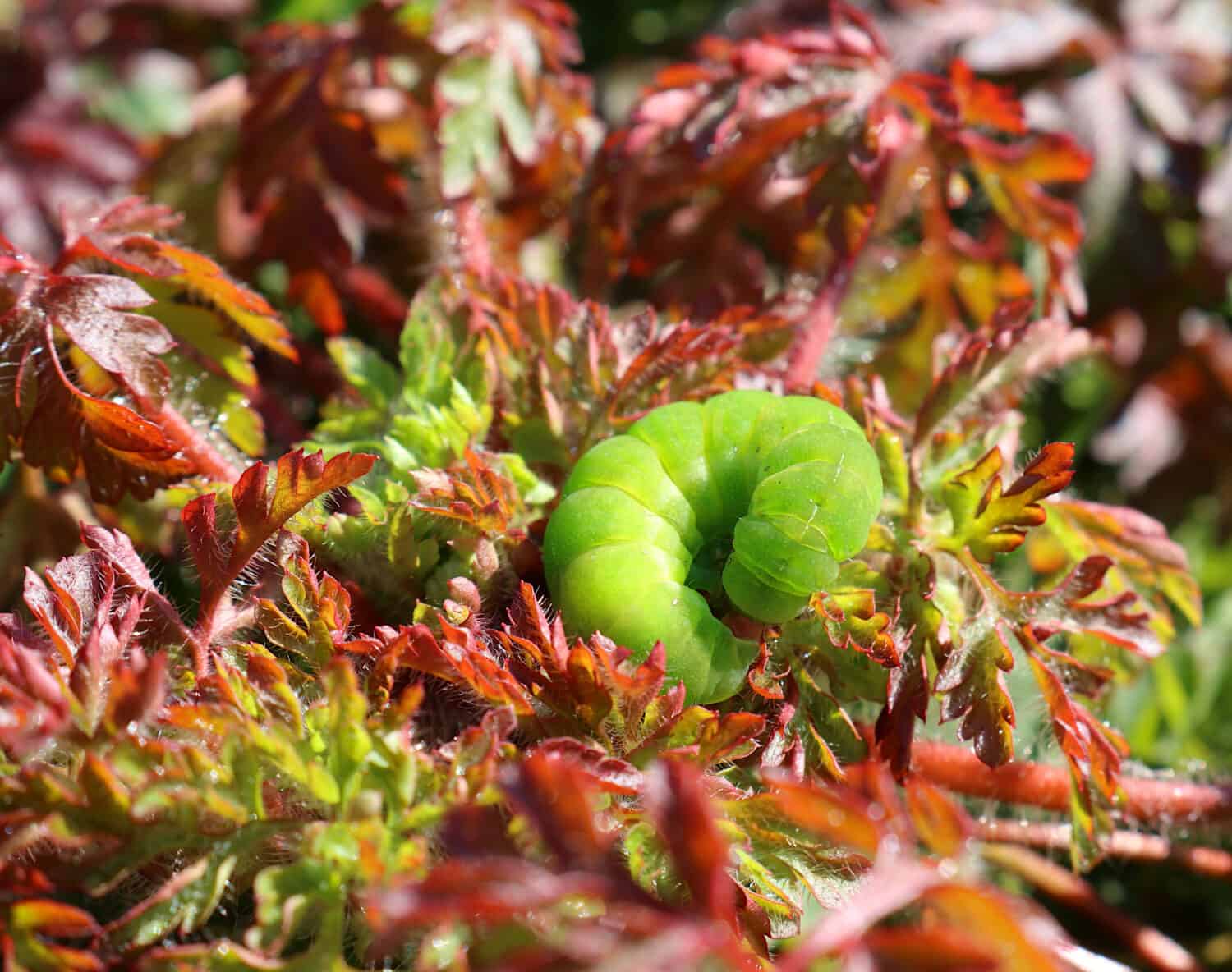
Angle-shade
caterpillars turn
into large brown moths with unique angular markings.
©Scorsby/Shutterstock.com
10. Polyphemus Moth Caterpillar
Last but not least is the Polyphemus caterpillar. They are native to North America and have large appetites. For example, this caterpillar can eat 86,000 times its weight in less than two months. When these small insects first emerge, they are bright yellow. However, they molt five times, eventually becoming bright green with silver spots on their sides. In the first few instars, these caterpillars are hairy and can sometimes resemble a cactus. These large caterpillars are also about 3 to 4 inches long. Polyphemus caterpillars have many predators, including the parasitoid wasp, which lays its eggs in young caterpillars, eventually killing them.
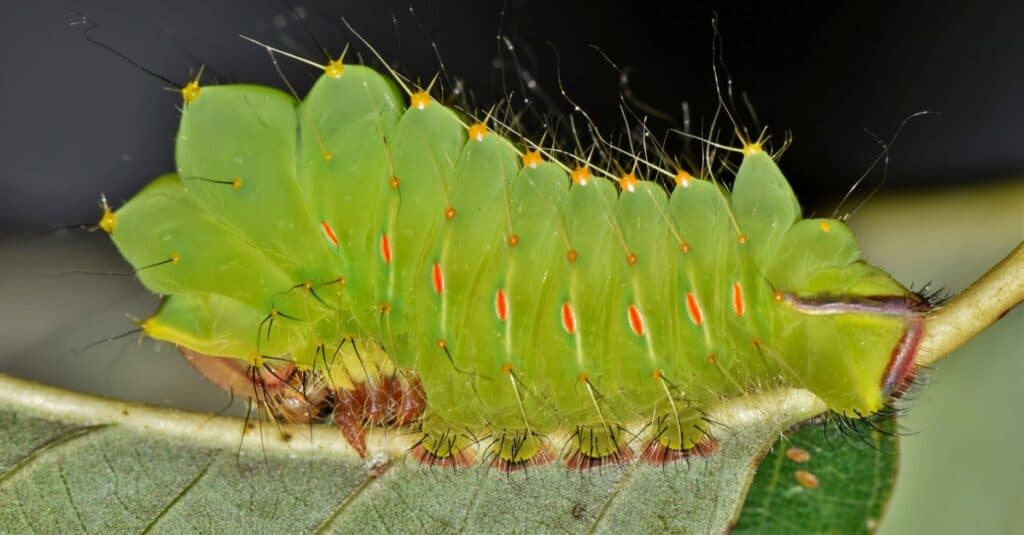
In the last instar, Polyphemus caterpillars are bright green with silver spots on their sides.
©Brett Hondow/Shutterstock.com
Summary of 10 Types of Green Caterpillars with Pictures and Identification
| # | Caterpillar | Appearance |
|---|---|---|
| 1 | Black Swallowtail Caterpillar | These long, vibrant caterpillars are green, orange, yellow, and black |
| 2 | Cecropia Moth Caterpillar | Covered in many tubercles that can be many colors including orange, blue, and yellow |
| 3 | Spicebush Swallowtail Caterpillar | Bright green, with yellow and black spots on top of their bodies helping them mimic the appearance of snakes |
| 4 | Eastern Tiger Swallowtail Caterpillar | Bright green with two black, yellow, and blue eyespots |
| 5 | White-lined Sphinx Moth Caterpillar | Ranges a lot in color but is usually green and orange |
| 6 | Cabbage Looper Caterpillar | Green – to match the cabbage they eat |
| 7 | Emperor Moth Caterpillar | Bright green with black rings and yellow and red spots |
| 8 | Tomato Hornworm | Sticky green with white and black markings |
| 9 | Angle Shade Caterpillar | Thick bodies in vibrant green |
| 10 | Polyphemus Moth Caterpillar | Hairy and green – resembling a cactus |
The photo featured at the top of this post is © Graphicato/Shutterstock.com
Thank you for reading! Have some feedback for us? Contact the AZ Animals editorial team.




